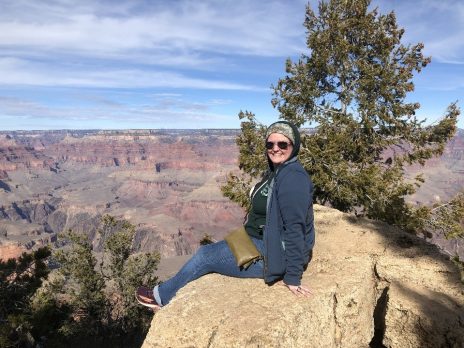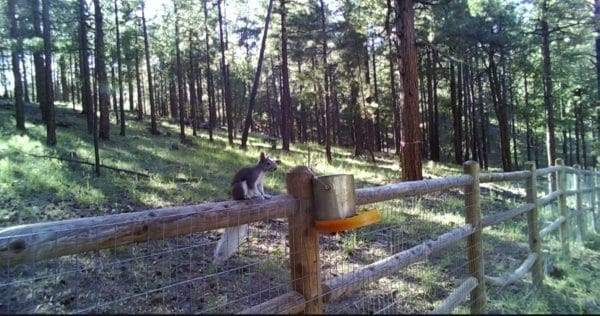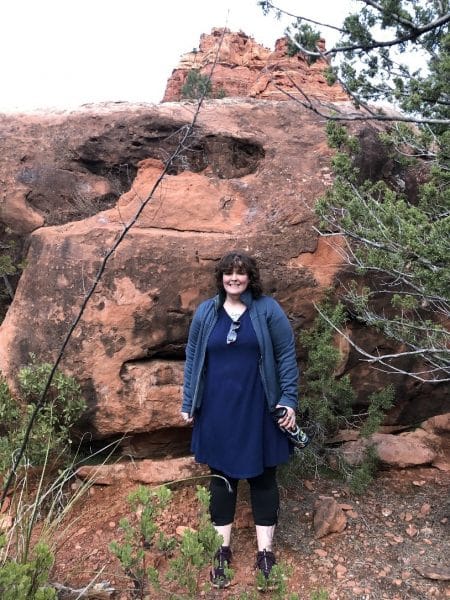My name is Shannon Medlock, I’m a first-year graduate student from Anchorage, AK studying at the University of Alaska Anchorage (UAA). I study the gut and milk microbial communities of arctic ground squirrels. For the Research Coordination Network (RCN) lab exchange I am collaborating with Dr. Greg Caporaso’s lab at Northern Arizona University (NAU) where I am looking at Aberts squirrels, sometimes called tassel-eared squirrels, and their gut microbial communities using samples collected by Victor Zhang. The project examines the impacts of urbanization on the squirrel’s physiology, behavior, and gut microbial ecology. These impacts are studied by collecting data from squirrels living in the Centennial Forest, a pristine location similar to their historic habitat, and from those living in urban backyard settings, then comparing these data sets. My expertise in fecal sampling and microbial DNA extraction made me the ideal researcher to determine if urbanization is impacting gut microbial communities in these squirrels. While the impacts of urbanization on animal demographics has been studied, little is known about how they are affected physiologically, behaviorally, or the influences on gut microbial communities.

My lab exchange experience had two parts. For the initial part I performed the lab bench work at my home university in Anchorage, then traveled to NAU to complete the second portion. In the spring of 2019, for the first portion of the lab exchange, I received 100+ squirrel fecal samples in the mail. When I began my career as a biologist, I had no idea how much poop I would have to handle, but poop has become essential to my scientific explorations! As a microbiologist studying host-microbe interactions, fecal samples are my bread and butter. Extracting microbial DNA from feces is a non-invasive method of determining gut microbial community composition as the fecal communities mimic the community present in the gut. Once the samples had been extracted, the resulting DNA was shipped back to NAU to be sequenced. When sequencing gut microbial communities to get a general idea of what microbes might be present, we target specific regions of the 16s rRNA gene sequence. This part of the bacterial genome is present in all bacterial species and has highly conserved regions across species and allows us to identify microbial community members present in the sample down to the genus and sometimes species level.

Once the DNA had been sequenced at NAU it was time to schedule the second part of the lab exchange, travel to NAU to complete the bioinformatics processing. To bolster my novice level of knowledge about the bioinformatics processing using the Quantitative Insights Into Microbial Ecology 2 (QIIME2) platform, I first attended a workshop in preparation for my time in the Caporaso lab. QIIME2 is an open source software with the capability to process the large data sets generated by the sequencing process and filter that into useable data. The workshop was hosted by the National Institutes of Health (NIH) in Bethesda, MD. It was an intensive 3-day workshop that provided the immersion into the QIIME2 world I needed before heading to Arizona.
The QIIME2 workshop was my first introduction to the QIIME2 team of researchers. I admit that I was incredibly intimidated to meet and interact with these scientists. While I am a biologist, I am definitely not a computer scientist and the level of knowledge they possess in both these areas had me nervous about spending a week with them in Arizona. It was such a relief as I got to interact with them in Bethesda to realize that they are amazing down-to-earth people who are incredibly encouraging and have a desire to help others succeed at their science. The workshop provided an introduction of the basic knowledge I needed to make the most of my time at NAU. Immediately following the workshop, I flew to Flagstaff, AZ.

My time in the Caporaso lab was incredibly productive. For the first couple of days I had the undivided attention of either Dr. Caporaso or Matt Dillon (the lab manager and QIIME2 expert). With their guidance, I began to understand how to write the code and what the all too common lines of red code (indicating an error of some kind) meant. When dealing with the large datasets we often have in microbiology due to the large number of microbial species in our samples, the processing is too much for a personal computer to handle and has to be done on a remote server with the capacity to handle this amount of data. These codes can take hours to run, especially in the beginning stages where the samples need to be demultiplexed. Demultiplexing is the process of separating the sequences by sample and removing the primers and adapters that were added during sequencing. I was lucky to have access to a server that allowed for fast computation so that I wasn’t waiting around too long! Next, I looked at the quality of the reads to determine if there were any sequences that should be filtered out due to low read quality. Once that was complete, I started working through the alpha and beta diversity metrics for the samples. Alpha diversity is a measurement of the diversity within a sample, while beta diversity compares between sample differences. By the third day, I had alpha and beta diversity charts to show Victor and his mentor, Dr. Loren Buck. During my meeting with Victor Zhang and Dr. Buck we also talked about ways we might incorporate some of the other data that was collected on these squirrels into my analysis. I’m excited about continuing to analyze the data with Victor and to see what we’ll find when looking at the influence urbanization is having on the squirrels.
While a large portion of my time was spent staring at a computer screen, I was given the opportunity to share the research we do in the Duddleston lab at UAA with the folks at NAU. I was honored to be invited by Dr. Caporaso to give the presentation at the monthly seminar for the Pathogen and Microbiome Institute. While this is my first time working with tassel-eared squirrels, I am no stranger to other species of squirrel, specifically arctic ground squirrels. My lab at UAA studies the gut microbes of arctic ground squirrels. We are the first and only lab studying the microbiota of arctic ground squirrels and I was able to share the research we’ve done in the past and what we’re currently working on with the arctic ground squirrels. My own project is looking at the influence of dietary protein on the gut microbiota of pregnant and lactating squirrels and how that impacts the gut colonization of their pups and the pup’s growth and development. It’s always exciting to share your science with other scientists and hear their input and questions.

When I could get away from working through the analysis, I spent some time marveling at the amazing Arizona scenery! I had time at the beginning of my stay to spend a day exploring Grand Canyon National Park. This is an amazing landmark that I hadn’t had the opportunity to see before this. I was sufficiently astounded at its grandness! The colors and scenery are so starkly different from the scenery in Alaska, it took my breath away to see the canyons, deserts, and historic dwellings. What an amazing place to visit! I was also able to visit Sedona one evening and spend some time hiking through canyons and up to the red rock spires. Walnut Canyon, with its cave dwellings and amazing views, was another of the sights just a few minutes from Flagstaff that thrilled me with its history and beauty. The sights of Arizona are truly spectacular!
The lab exchange through the RCN was an amazing experience. I gained valuable knowledge of bioinformatics that I will be able to apply for the rest of my career, I expanded my network of research scientists to collaborate and partner with, and I participated in research that will expand my impact in the scientific community. Now that I am back at my home university, I am sharing the knowledge I gained about bioinformatics processing with other students in my lab by leading weekly lab meetings. During the meetings I was able to walk through the analyses I performed and answer general questions about how the workflow went. I am excited about the continued processing of the data on the Aberts squirrel project and applying this new knowledge and experience to my own research and that of my lab mates. Special thanks to Dr. Loren Buck, who encouraged me to apply for the exchange. My mentor at UAA, Dr. Khrys Duddleston, in coordinating the exchange and encouraging me in this pursuit. I am also incredibly appreciative of Dr. Caporaso and his team who were so incredibly helpful and wonderful to work with.